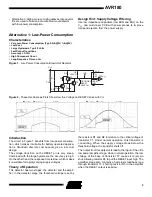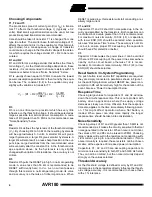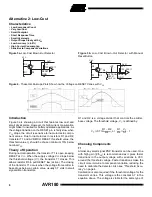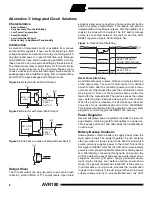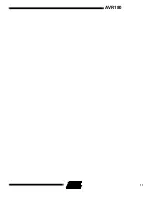
AVR180
4
Choosing Components
T1, T2 and T3
The production spread of current gain
β
(or h
FE
) in transis-
tors T1 affects the threshold voltage V
T
(typically ± 0.2
volts). Most small signal transistors can be used, but low
production spread transistors are recommended.
Care should be taken if transistor T1 is changed from one
type to another. The emitter-base threshold voltage of T1
affects the constant (0.4) in the equation for threshold volt-
age (below). As a consequence, a change of transistor
could cause a change in the threshold voltage of the detec-
tor, which requires the voltage divider R1 + R2 to be recal-
culated.
R1 and R2
R1 and R2 forms a voltage divider that defines the thresh-
old voltage V
T
. As the threshold voltage depends on these
resistors, it is recommended to choose resistors with 1%
tolerance or better. Also see “Noise Sensitivity” below.
R1 is usually chosen equal to 10 M
Ω
to ensure the lowest
power consumption possible. R2 is then found by the equa-
tion below. The constant (0.4) in the equation may vary
slightly with variations in transistor T1:
R3
R3 is a non-critical pull-up resistor which has very little
influence on the threshold voltage. It should be selected as
large as possible to minimize power consumption. A resis-
tance of R3 greater than 10 M
Ω
is not recommended, see
“Noise Sensitivity” below.
R4
Resistor R4 defines the hysteresis of the threshold voltage
(V
T
). By choosing R4 to 3.3 M
Ω
, the resulting hysteresis
will be approximately 0.3 volts. A smaller R4 will give a
larger hysteresis, a larger R4 gives smaller hysteresis. A
larger R4 will also result in a less sharp transition in the out-
put slope. Large deviations from the recommended value
will eventually alter the constant 0.4 in the threshold volt-
age equation above. As the hysteresis is only slightly
changed with variation in R4 resistance, the accuracy is not
critical.
R5
Resistor R5 pulls the RESET pin high in normal operating
mode. A value less than 50 k
Ω
is recommended to tie
RESET sufficiently hard to V
CC
. As no current passes
through this resistor in normal operating mode, its value
and accuracy is otherwise of little importance. When
RESET is pulled low, this resistor will start conducting a rel-
atively large current.
C1 and C2
Capacitors C1 and C2 short RF noise picked up in the cir-
cuitry and amplified by the transistors. Both capacitors can
be omitted, but a value greater than 1nF is recommended.
For maximum noise immunity, 100 nF (LF) or capacitors
with lower ESR (HF) should be selected when possible.
Also see “Response Time” below. The accuracy is not criti-
cal, but to ensure proper RF decoupling, the capacitors
should have Z5U dielectric or better.
C3
Capacitor C3 decouples the power lines. It can be omitted
if there is RF decoupling of the power lines somewhere
nearby on the circuit board, otherwise 1nF is recom-
mended. For maximum noise immunity, 100 nF (LF) or low
ESR (HF) should be selected.
Reset Switch / In-System Programming
If a push button reset and/or ISP capabilities are required,
they are simply connected in parallel as shown in Figure 1.
As the switch/programmer will pull RESET low, power con-
sumption in R5 will be relatively high for the duration of the
event. Also see “Power Consumption” below.
Response Time
Choosing large values for capacitors C1 and C2 will slow
down the circuit’s response time. This is not a problem with
battery driven applications where the supply voltage
decreases slowly over time. Observe that the response
time also applies to the time immediately following power-
on. This might affect operation when a flat battery is
loaded. When power can drop more rapidly, the longer
response time should be taken into consideration.
Noise Sensitivity
Choosing values of R1 and R3 greater than 10 M
Ω
is not
recommended, as it makes the circuitry sensitive to thermal
noise generated in the resistor. When noise is not critical,
the values of R1 and R3 can be raised to 20 M
Ω
. Choosing
larger values will result in the resistors not conducting suffi-
cient current, giving in a non-functional detector. If more
noise immunity is required, these resistors can be chosen
smaller, at the expense of increased power consumption.
Capacitors C1, C2 and C3 are decoupling capacitors to
minimize noise sensitivity to both RF and 50/60 Hz fields.
They can all be omitted, but the noise immunity depend
strongly on the values selected.
Threshold Accuracy
As the threshold voltage is defined mainly by R1 and R2,
inaccuracies in these resistors directly influence the thresh-
old voltage accuracy. It is recommended to choose these
with ± 1% tolerance.
V
T
R1 R2
+
(
)
0.4
R2
--------
or R2
0.4 R1
⋅
V
T
0.4
–
---------------------
=
,
⋅
=
Summary of Contents for AVR180
Page 10: ...AVR180 10...
Page 11: ...AVR180 11...



